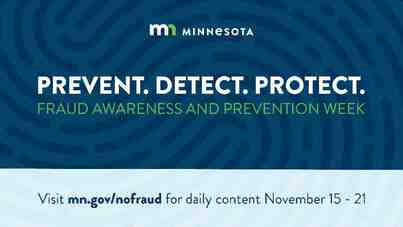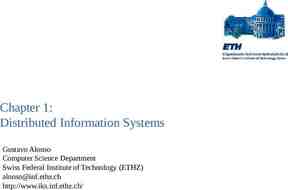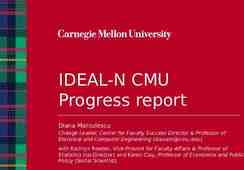Academic Portfolios Medicine Sarina Schrager, MD,MS University of
23 Slides223.50 KB

Academic Portfolios Medicine Sarina Schrager, MD,MS University of Wisconsin Department of Family

What is an academic portfolio? Collection of materials that describe your academic work Different than a CV—includes some reflection and evaluation Not just publications and presentations

Goals of an Academic Portfolio Demonstrate breadth of learning, teaching, and research Range of achievements. Collecting and connecting your various accomplishments; a creative representation of your work and of you Evaluate achievement of intended outcomes Opportunity to showcase your accomplishments. Your best work Reflect, assess own educational experience Representative pieces; written reflections. To make connections between where you were, where you are, and where you want to be Illustrate the learning process Multiple drafts -- a process. To document teaching and research as it evolved over time. Share one’s expertise Legacy of best practices in both teaching and research. USC

Four Basic Processes for the Creation of an Academic Portfolio Collection A relatively short collection of materials that summarizes and highlights an individual’s activities as a teacher and researcher. Selection Why are you creating the portfolio? Who is reading it, and why? Reflection Thinking critically about your total learning, teaching, and research experiences Connections Making personally meaningful connections between Your teaching, Your field of research, its body of knowledge, and its applications Your service and community experiences USC

A Document that Evolves Over Time Remember: The portfolio is a living collection of documents and materials which change over time New items are added, others are dropped. Once each year, when the research and service section of the curriculum vitae are updated, the same is done for the portfolio’s teaching and research sections. USC

Advantages of an Academic Portfolio The Section on Teaching Provides the stimulus and structure for self-reflection about areas of teaching (including those needing improvement) o Concentrates on reflective analysis, action planning, and assessment of student learning. o Provides evaluators with hard-to-ignore information on what a professor does in a classroom and why he/she does it. The Section on Research Provides the stimulus and structure for self-reflection about areas of research that may lead to inter-disciplinary collaboration Provides colleagues with the opportunity to contribute to the portfolio’s creation through feedback and file exchanges Excerpts of Portfolio can be used in successful grant applications Used as credentials for those seeking academic positions USC

What is in an educator’s portfolio? Philosophy of Education - Personal theory of learning and teaching Curriculum Development/Instructional Materials - Design, development and evaluation of curricula/programs Teaching Skills - Documentation of teaching by target audience, year and topic www.mcw.edu

What is in a portfolio (cont.)? Assessment of Learner Performance - Construction and implementation of examinations/methods of assessment Adviser - Lists of formal and informal advisees Educational Administration - Leadership and management in education www.mcw.edu

Portfolios (cont) Educational Scholarship - Leadership and management in education Continuing Education - Evidence of growing knowledge and skills as an educator Honors and Awards - Recognition by peers and students Long Term Goals - Reflection on portfolio and future plans www.mcw.edu

How to get started Clarify teaching responsibilities. Select items for the Portfolio. Prepare statements on each item Arrange the items in order. Compile the supporting data. Incorporate the Portfolio into the curriculum vitae. Physical presentation considerations. www.utexas.edu

When should you start your portfolio? On day one of your job Should be a “work-in-progress” Can use as a storage space Should evaluate yearly

Philosophy of education/clinical work Articles Personal experiences Fiction, quotes Spend some time thinking about why you are in academic medicine vs. private practice Can evolve over time

Curriculum Development/Instructional Materials Copies of talks (include student groups, CME, community, etc) Curriculum—paper, online Handouts Manuals

Teaching skills Resident/student evaluations Lecture evaluations Teaching awards Direct feedback from students and residents CME evaluations

Assessment of learner performance Test questions Related to curriculum development Pre and post tests

Advisor Medical student Resident Colleague PA/NP/Nurse

Educational/clinical administration Course director Rotation coordinator Med school or residency committees Make notes while you are on committee (frequency of meetings, outcomes, etc.)

Educational/clinical scholarship All research goes here—grants, student projects, papers All innovative curriculum/lectures/new models, etc. should be evaluated. Study what you do (and document it here)

Continuing education Conference brochures Specific talks or workshops that directly relate to your area(s) of interest/expertise Listservs, journals

Honors and awards Include a description of the award

Long term goals Re-evaluate annually Work-in-progress Sort of like a professional development journal

How to get started? Accordion file Web-based accounts (i.e. file all lecture evals, e-mail feedback from students, residents) Make 10 electronic folders with the same headings as the paper ones

Examples http://medschool.ucsf.edu/academy/memb ership/categories.aspx#cat1 (UCSF—website has specific examples of how to document material for portfolio) http://www.utexas.edu/academic/cte/teach folio.html (University of Texas at Austin- a handbook of “Preparing a teaching portfolio”






